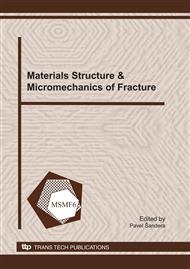p.61
p.65
p.69
p.73
p.77
p.81
p.85
p.89
p.93
Influence of Dislocations on the Spatial Variation of Microstructure in Martensites
Abstract:
The continuum theory of dislocations, as developed predominantly by Kröner and Kosevich, views each dislocation as a source of incompatibility of strains. We show that this concept can be employed efficiently in the Landau free energy functional to develop a mean-field mesoscopic model of materials with dislocations. The order parameters that represent the distortion of the parent phase (often of cubic symmetry) are written in terms of elastic strains which are themselves coupled by incompatibility constraints. Since the “strength” of the incompatibility depends on the local density of dislocations, the presence of dislocations affects the evolution of the microstructure and vice versa. An advantage of this formulation is that long range anisotropic interactions between dislocations appear naturally in the formulation of the free energy. Owing to the distortion of the crystal structure around dislocations, their presence in multiphase materials causes heterogeneous nucleation of the product phase and thus also shifts of the transformation temperature. This novel field-theoretical approach is very convenient as it allows to bridge the gap in studying the behavior of materials at the length and time scales that are not attainable by atomistic or macroscopic models.
Info:
Periodical:
Pages:
77-80
Citation:
Online since:
January 2011
Authors:
Keywords:
Price:
Сopyright:
© 2011 Trans Tech Publications Ltd. All Rights Reserved
Share:
Citation:


